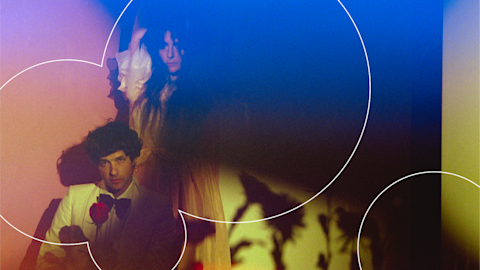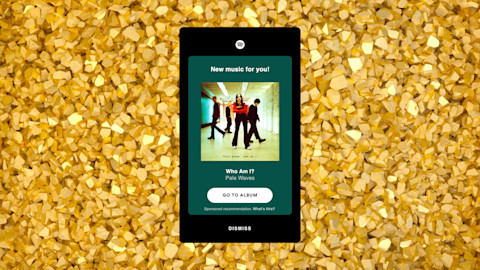The legendary Jean-Michel Jarre was one of the world’s first electronic music superstars. His 1976 smash hit album Oxygene put the French musician on the global stage, and remains a pillar of the electronic music canon. To date, Jarre has sold over 80 million albums, and he’s still actively making music and touring. We caught up with him by phone recently as he prepares to kick off a rare US tour, including an appearance at Coachella.
Spotify For Artists: You have decades of experience making electronic music. What’s your advice for electronic musicians starting out now?
Jean-Michel Jarre: Very simple advice, very useful: In days where technology is making you believe that you can do everything, and there are no limits in arts in general, the most important thing is limitation.
So these days, because technology is offering so many possibilities, you have to create your own limitations: Choose one device, one piece of hardware, one plugin, whatever you like. When you are choosing that, try to stay with that for six months or one year. Try to explore the instrument yourself, [find] what you are trying to say, what the machine or the instrument is trying to give you.
You can have hundreds of modules and the result is probably disappointing, because it’s the same kind of drones. With modular [synthesizers] and euroracks now, it’s a hard drug, an addiction. It makes me think of some audiophile people, who are obsessed with turntables and amplifiers and the quantity of copper in a cable rather than listening to music — the rest of their life will be about equipment. The key is actually to choose carefully what you want, and just stay with this for one year.
I think that today, with technology everywhere, I think electronic music has a role to play today in the future. As electronic musicians, we are the closest artists to technology and to technological concepts such as the Internet. And of course, my last project was electronica, a project around tech, the dark side of tech. I worked with Massive Attack on a track called “Watching You,” [and explored] what love is about in the age of Tinder, and my collaboration with Edward Snowden. I am quite proud to have collaborated with Edward Snowden and to have him involved in Coachella in the US, where we know that everything is not exactly what we would hope to say the least.
So Snowden is going to be part of your live set.
Absolutely. He made me think of my mother — my mother was part of the French Resistance. I admire the courage of this guy. He was a true soldier. It’s why I wanted to collaborate with him. On top of it he is a big fan of electronic music and he knew my music. He was quite happy. He wasn’t an artist and didn’t have that kind of pretension; he was an engineer…
I will bring a prototype to the US tour, a big touch screen, a Minority Report type of screen, to keep the tactile approach. At the end of the day, we are analog animals.
You have a background in visual arts.
I went to the Beaux-Arts, a French school, [studying] fine arts, doing abstract paintings. I was influenced very much by people like Jackson Pollock or Hans Hartung in Germany or Pierre Soulages in France — this abstract kind of painting. When I discovered electroacoustic music and studied that, I thought it was like Jackson Pollock in sound.
You also have a background in avant-garde and experimental music. You worked at the famed GRM Studios in Paris, and knew the late composers Pierre Schaeffer and Pierre Henry. You also worked in Cologne with Stockhausen. Talk a bit about that.
When I went into the GRM, and [heard] the music in the center, I was blown away by it. This was exactly what I wanted to do. This was a time of the student revolution — to react and rebel against the establishment of classical music, and the establishment of rock. At that time, Schaeffer as you know, he was one of the first [to say that] music is not based on notes, but music is based on sound — you can record the sound of rain, the sound of the streets and make music with it. You can choose your own range of colors and textures. For me, it was actually what I wanted to do. I was studying visual arts in those days — acoustically, it was the transposition for the ears.
Pierre Henry passed away a few months ago. I was very close to their families. The music they were doing was very serious avant-garde experimental music. But they were quite crazy people – it was like crazy fantasy music, and Pierre Schaeffer was quite formal but he was quite crazy.
I had the opportunity to work with Stockhausen. Mr. Stockhausen was really crazy in the right sense of the word (laughs). It was actually very interesting, because we were talking about electronic music — Schaeffer and Pierre Henry were more electroacoustic, with sound design and sampling. Today, [when] we do sampling and sound design, we all owe a lot to Pierre Schaeffer. Stockhausen had more of a pure electronic music approach, using oscillators and filters. Schaeffer and Henry were using this stuff, but less than Stockhausen.
Your live performances are tremendous audiovisual experiences. Can you talk about the importance of visuals?
Mixing visuals with music has always been very important. I was one of the first musicians to involve that, on that level, on that scale. Because electronic music is not like musicians playing instruments where the sound is coming from violin or trumpet or whatever. For electronic music, it’s more abstract. It’s behind desks, or synths. It’s not the most exciting thing to see somebody behind a machine when you don’t understand what is going on. That’s why integrating visuals with electronic music is very important for performance.
-Geeta Dayal


